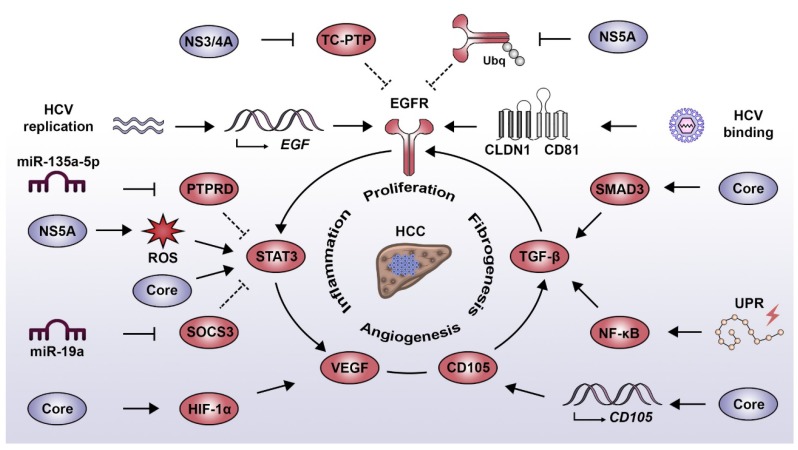Figure 1.
Interplay between HCV-induced oncogenic signaling pathways. EGF pathway: HCV binding to its entry receptor complex (i.e., CLDN1/CD81) induces EGFR phosphorylation. This is sustained by the action of NS3/4A and NS5A which negatively regulate the phosphatase TC-PTP and the process of EGFR degradation, respectively. Additionally, HCV replication has been linked to the increased expression of EGF and activation of the TGF-β pathway, both contributing to EGFR signaling. STAT3 pathway: STAT3 activation results from the direct action of the core protein and indirectly via EGFR activation and the NS5A protein, which favors the production of ROS. Moreover, HCV employs miR-135a-5p and miR-19a to decrease the expression of the negative STAT3 regulators PTPRD and SOCS3, respectively. TGF-β pathway: HCV induces the activation of the TGF-β pathway by intermediary of the UPR, which favors NF-κB activity and via the core protein, which directly interacts with SMAD3. The HCV-mediated expression of endoglin (CD105) favors activation of the TGF-β pathway and the induction of angiogenesis signaling. VEGF pathway: HCV core induces the activation of HIF-1α, which leads to an increased expression of VEGF. Similarly, an increased VEGF expression is promoted by HCV via the STAT3-dependent activation of androgen receptor. Abbreviations: CLDN1, claudin 1; EGF, epidermal growth factor; EGFR, epidermal growth factor receptor; HCC, hepatocellular carcinoma; HCV, hepatitis C virus; HIF-1α, hypoxia-inducible factor 1 alpha; NF-κB, nuclear factor kappa B; PTPRD, protein tyrosine phosphatase receptor type delta; ROS, reactive oxygen species; SMAD3, SMAD family member 3; SOCS3, suppressor of cytokine signaling 3; STAT3, signal transducer and activator of transcription 3; TC-PTP, T cell protein tyrosine phosphatase; TGF-β, transforming growth factor beta; UPR, unfolded protein response; VEGF, vascular endothelial growth factor.

